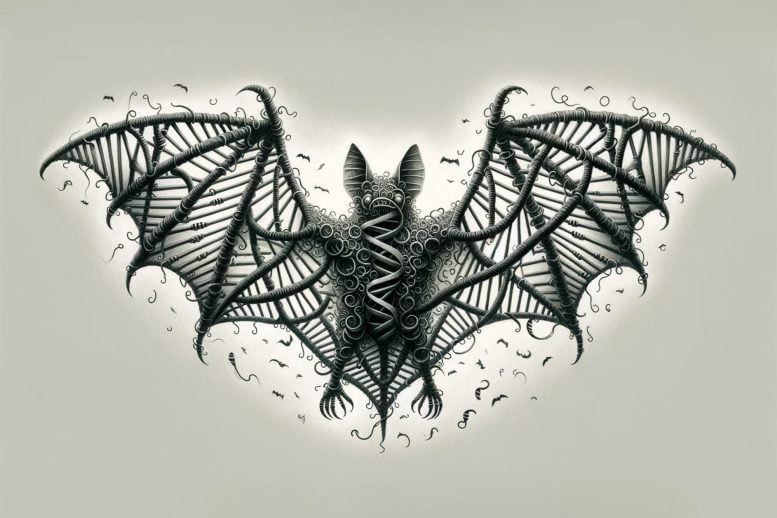
Researchers discovered significant genetic diversity among leaf-nosed bats in the Solomon Islands, revealing that similar-sized bats on different islands are genetically distinct species. This finding challenges previous morphological classifications and has implications for conservation and understanding evolutionary processes. Credit: SciTechDaily.com
Genetic analysis of Solomon Islands leaf-nosed bats shows unexpected diversity, suggesting unique conservation needs and challenging previous size-based classifications.
Researchers from the University of Melbourne and the University of Kansas have discovered significant genetic diversity among leaf-nosed bats in the Solomon Islands, despite their similar appearances on different islands. This research, published in the journal evolutioninvolved the collection of field specimens and genetic analysis.
“This is a genus of bats called Hipposideros with multiples spices throughout Southeast Asia to the Pacific,” said co-author Rob Moyle, senior curator of ornithology at the KU Biodiversity Institute and Natural History Museum, whose lab conducted much of the research. “In the Solomon Islands, where we have been doing a lot of fieldwork, there may be four or five different species, and they are analyzed in terms of body size. There is a small, medium, or large there are more than three species, there is a small, medium, large and extra large. There are five on an island, so there is a smaller one.”
Details and conclusions of the study
According to Rob Moyle, who also serves as a professor of evolutionary biology at KU, previous research based solely on physical traits concluded that bats of similar size on different islands were all the same species. “You go from island to island, and the medium-sized species is identical to the other islands,” he said. “Biologists have always looked at them and said, ‘OK, it’s obvious.’ There is a species of small, medium and large size distributed over several islands’”.

Islands in the Vona Vona lagoon of the New Georgia group, Solomon Islands. This group of islands is home to four species of Hipposideros bats, including the two that appear in the study of convergent evolution across the archipelago. Credit: RG Moyle
However, Moyle and his collaborators had more modern analyzes at their disposal. By sequencing the DNA of bats they collected from the field (along with specimens from museum collections), the team found that large and extra large bat species were not really related.
“This means that somehow these populations got to this identical body size and appearance not because they were closely related, but we usually think of identical-looking things that way because they are closely related,” Moyle said. “It raises questions like what is unique about these islands that you would have convergence of body size and appearance into really stable size classes across different islands.”
The team made precise measurements on bats from different islands, confirming previous work by scientists in the Solomon Islands.
“All the greats from different islands were lumped together in their measurements,” Moyle said. “It’s not just that the early biologists made a mistake. They looked at them and said, ‘Oh, yes, they’re the same.’ And they’re not. We measured them and they’re all grouped together, even though they’re different species . We have verified, somewhat, this previous morphological work.”

Photographs of a Guadalcanal field demonstrating the size difference between the sympatric species H. diadema and H. dinops. Credit: Lavery et al
“When we created family trees using bat DNA, we found that what we thought was just one species of large bat in the Solomon Islands was actually a case where the larger bats had evolved from the larger species several times on different islands,” Lavery. said “We think these larger bats might be evolving to take advantage of prey that smaller bats don’t eat.”
Implications for conservation and evolutionary biology
DeRadd said the work could be “highly relevant” to conservation efforts to identify evolutionarily significant units in this group.
“Body size had fooled the taxonomy,” DeRadd said. “It turns out that the population of giant bats on each island is basically genetically unique and deserves to be conserved. Understanding that is very helpful. There are problems with deforestation. If we don’t know if these populations are unique, it’s hard to know whether we should try -us to preserve them”.
According to DeCicco, the new understanding of leaf-nosed bats was fascinating on a purely theoretical level.
“We study the evolutionary processes that lead to biodiversity,” he said. “This shows that nature is more complex. We humans love to try to find patterns, and researchers love to try to find rules that apply to large sets of organisms. It’s great when we find exceptions to those rules. These are patterns that you see duplicates in many different taxa on many different islands – one large and one small species, or two closely related species that differ in some way to divide their niches – we are seeing that there are many different evolutionary scenarios that can produce the same pattern “.
Reference: “Parallel evolution in an island archipelago revealed by genomic sequencing of Hyposideros leaf-nosed bats” by Tyrone H Lavery, Devon A DeRaad, Piokera S Holland, Karen V Olson, Lucas H DeCicco, Jennifer M Seddon , Luke KP Leung and Robert G Moyle, 8 Mar 2024, evolution.
DOI: 10.1093/evolut/qpae039
#Unmasking #genetic #illusion #Solomons #bats #defy #appearances
Image Source : scitechdaily.com